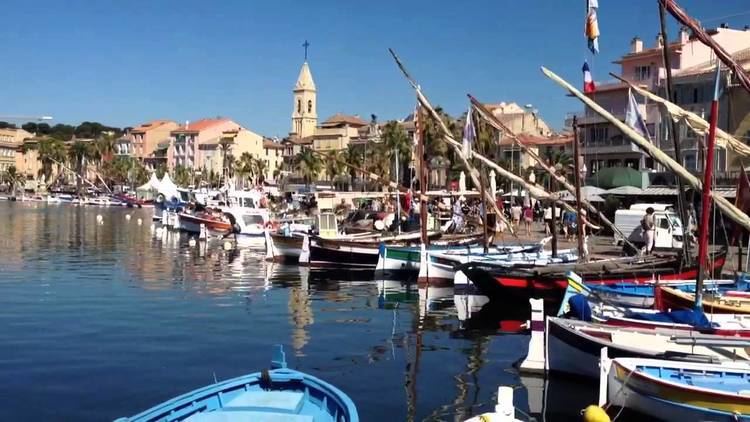INSEE/Postal code 83123 /83110 Population 17,774 (2007) | Department Var Time zone CET (UTC+1) Area 19.24 km² Local time Tuesday 7:39 AM | |
 | ||
Weather 12°C, Wind SE at 2 km/h, 89% Humidity Points of interest French Riviera, ZOA Sanary Bandol, Grotte du Garou | ||
Sanary-sur-Mer is a commune in the Var department in the Provence-Alpes-Côte d'Azur region in southeastern France.
Contents
Map of Sanary-sur-Mer, France
It is located in coastal Provence on the Mediterranean Sea 13 km (8.1 mi) from Toulon and 49 km (30 mi) from Marseille. It can be reached from Paris by TGV train in less than 4 hours. In high season there are direct flights to nearby Toulon from London, Oslo, Brussels and Rotterdam.
Overview
The seafront location was part of the commune of Ollioules. In the 16th century the seigneur established a fishing village here, clustered around the medieval watchtower, under the protection of "Sanct Nazari" of Lérins Abbey. The port was constructed and the harbor deepened in the mid-16th century. The little fishing port known in the Provençal dialect of Occitan (or in Provençal if considered as a dinstinct language) as Sant Nazari, later Sant Nàri, contracted later on as Sanàri, was finally granted its independence from Ollioules by Louis XIV of France on 10 July 1688, and on 12 November 1890 officially received its Francized name, Sanary, which was formalized and distinguished as sur-Mer on 27 July 1923.
As a tourist rendezvous, the village underwent a strong decade of growth in the 1980s.
Sanary has a beautiful coast line with small beaches; unlike most small towns on the Mediterranean coast it is an active village all year round. Sanary-sur-Mer is probably the sunniest place in France, with an average of only 61 days of rain, mostly in winter, and solar radiation (6156 MJ/m2/yr), comparable to Sicily. Sanary is regularly swept by the Mistral, a strong wind coming from the Rhone Valley, which brings low humidity around 20%, gusts up to 130 km/h (81 mph), very cool temperatures, sun and deep blue skies. Wind is near gale force or higher on average 115 days per year, and storm force 8 days per year, making Sanary a favorite destination for windsurfers.
Main sights
Jacques Cousteau had a house in Sanary, the Villa Baobab. He was a pioneer of deep sea diving equipment, which he invented and developed around Sanary. The Frédéric Dumas International Diving Museum is in a 13th-century Romanesque tower made available by the municipality; it bills itself as an historical city of diving. Frédéric Dumas was a co-inventor with Cousteau of the aqua-lung.
Sanary was the birthplace of Ernest Blanc (1923-2010), a distinguished operatic baritone who enjoyed a long international career.
Sanary hosts every year during the month of May the prestigious international photography festival PHOTOMED, now also held in parallel in Beirut.
Literary Sanary
With the rise of Nazism in the early 1930s, a great number of German writers and intellectuals left Germany and settled here: the playwright Bertold Brecht, Egon Erwin Kisch, Thomas Mann, Ludwig Marcuse, Joseph Roth, Franz Werfel and his wife Alma Mahler widow of Gustav Mahler at Le Moulin Gris (near the Chapelle Notre-Dame-de-Pitié), Lion Feuchtwanger at Villa Lazare then at Villa Valmer, and Arnold Zweig. Patronised by Jean Cocteau and his coterie, Sanary had already drawn Aldous Huxley, who wrote Brave New World at Villa Huley, and his wife, Maria; they attracted other English visitors, such as D. H. Lawrence and his wife, Frieda; Julian Huxley and his wife, Juliette; and others. The German expatriates clustered around Thomas Mann and his large family, his brother Heinrich and his wife (the model for Blue Angel), the writers Stefan Zweig and Arnold Zweig, the art critic Julius Meier-Graefe, and the artist René Schickele. Sybille von Schoenebeck (later, as Sybille Bedford, the author of A Legacy) lived here with her mother. Ludwig Marcuse in his book "Mein Zwanzigstes Jahrhundert" (p. 160) wrote about Sanary: "Wir wohnten im Paradies - notgedrungen" - we lived in paradise, against our will.
"If one lives in exile," wrote Hermann Kesten, "The café becomes at once the family home, the nation, church and parliament, a desert and a place of pilgrimage, cradle of illusions and their cemetery... In exile, the café is the one place where life goes on."
With the declaration of war in 1939, the French government treated these exiles as enemy aliens and interned some of them in camps like the concentration Camp des Milles near Aix-en-Provence, and eventually some were sent to Auschwitz. After liberation, the whole episode went ignored until the 1990s when, perhaps thanks to the increasing number of tourists from Germany, a commemorative plaque was unveiled, and literary itineraries were signposted.
Twin towns — Sister cities
Sanary-sur-Mer is twinned with:
